Books
Books
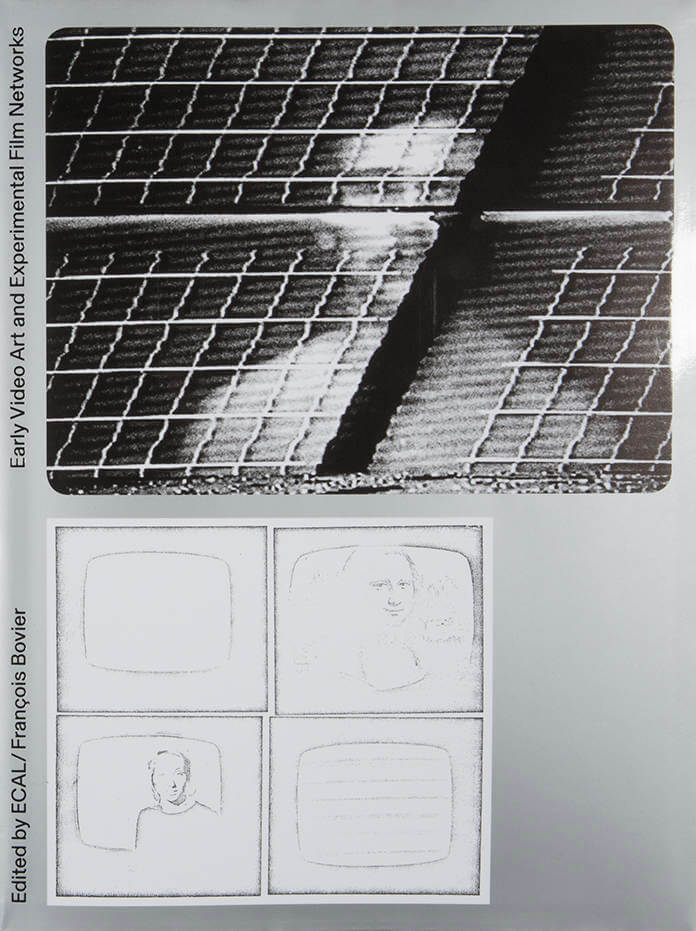
ECAL (Lausanne University of Art and Design)
Early Video Art and Experimental Films Networks
An international history of video art and experimental cinema networks in the early 1970s: the volume casts a new eye on various exhibitions, broadcasts and production and distribution structures, including a case study on Jonas Mekas' Anthology Film Archives.
Early Video Art and Experimental Films Networks traces the diffuse international networks through which video art and experimental films circulated during the late sixties and early seventies. It explores forgotten exhibitions both in Switzerland and France, the activities of public television channels and alternative art spaces in the US, a production art center dedicated to video in Italy and an Argentinian collective of conceptual artists, aiming to shed new light on the production and diffusion of moving images.
This volume is divided into two parts: the first part, which is longer and more extensively documented, explores the emergence and consolidation of video art networks at international level; the second focuses more specifically on two exhibitions of artists' films (New Forms in Film and Une histoire du cinéma) and one of the main instances of the museification of experimental cinema, Anthology Film Archives. Indeed, this particular story has wider currency insofar as several important works in recent years have focused on artists' films 23 and expanded cinema 24. We have adopted the principle, wherever possible, of providing rare and previously unpublished images and documents alongside the essays specifically commissioned for this volume, the choice of which has been left to the discretion of the author of each particular chapter.
Texts by Kristen Alfaro, François Bovier, Enrico Camporesi, Katarzyna Cytlak, Larisa Dryansky, Tristan Lavoyer, Adeena Mey, Kris Paulsen, Cosetta G. Saba, Andrew V. Uroskie.
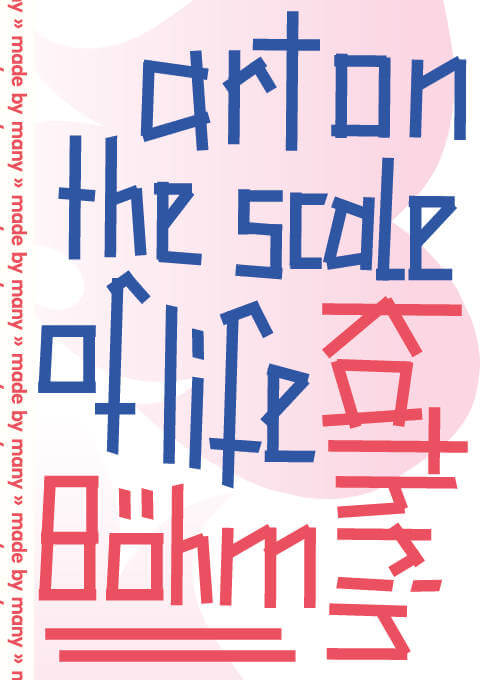
Art on the Scale of Life
A comprehensive overview of artist Kathrin Böhm's multifaceted, deeply collaborative, and durational practice and networks.
This volume critically profiles, contextualizes, and theoretically elaborates the unique practice of the UK-based German artist Kathrin Böhm. Combining visual and textual material, it offers an overview of Böhm's exceptional modus operandi that is rooted in a highly original artistic synthesis of a range of practices. Over the last three decades, Böhm has expanded the terms of socially engaged ways of working to an unprecedented scale and breadth by producing complex organizational, spatial, visual, and economic forms. These often entail the production of complex infrastructures, manifested via projects such as Culture is a Verb (2018–21), The Centre for Plausible Economies (2018–ongoing), Company: Movements, Deals and Drinks (2014–ongoing) and the Eco-Nomadic School (2010–ongoing). The book follows a major mid-career exhibition at The Showroom, London, in 2021.
Offering a significant addition to debates on contemporary art and architecture, social action, and public culture, Kathrin Böhm: Art on the Scale of Life brings together critical reflections by internationally acclaimed contributors. Spanning a wide range of critical positions and disciplines, these include Dave Beech, Céline Condorelli, Elvira Dyangani Ose, Wapke Feenstra, Katherine Gibson, Joon-Lynn Goh, Lily Hall, Yolande Zola Zoli van der Heide, Grace Ndiritu, Gerrie van Noord, Paul O'Neill, Doina Petrescu, Gregory Sholette and THEMM!!, Kuba Szreder, Gavin Wade, Mick Wilson, Stephen Wright, and Franciska Zólyom. In addition, material derived from Böhm's international networks and projects provides an in-depth impression of the deeply ingrained collaborative and durational nature of her way of working.
Photographic, diagrammatic, and typographical imagery runs through the book, demonstrating the rich visual and spatial languages embedded in Böhm's work. This visual register of the book is therefore much more than a series of illustrations and acts as a counterpoint to, and extension of, the ideas elaborated in the texts.
Kathrin Böhm is an international artist based in London. Her work takes place in and outside the art world, as she engages with governance, economics and different trans-local communities. Her main interests are the collective (re-)production of public space, trade as public realm and the everyday as a starting point for culture.
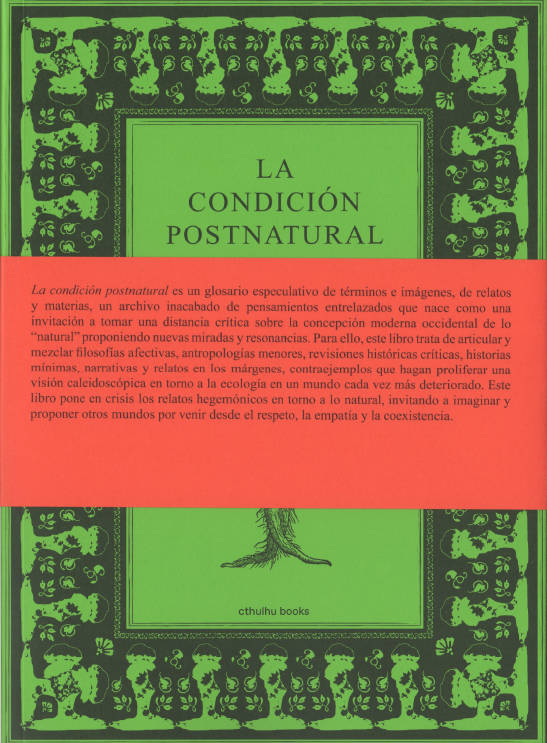
La condición postnatural
What is postnature? How to understand the socio-climatic crisis and where to look for new narratives for a desirable future? What is the relationship between contemporary ecology and artistic practices? The postnatural condition is a speculative glossary of terms and images, of stories and materials, an unfinished archive of intertwined thoughts. This book, which includes theoretical texts, situated examples, and artistic projects, presents a critical view of the modern Western conception of the "natural" and proposes new perspectives and resonances. Mixing affective philosophies, minor anthropologies, critical historical revisions, minimal histories, narratives, and stories on the margins, it seeks to proliferate a kaleidoscopic vision around ecology in an increasingly deteriorating world, inviting us to imagine and propose other worlds to come from respect, empathy, and coexistence.
Texts by Gabriel Alonso & Clara Benito with collaborators: Paloma Villalobo, Valentín Bansac, Nicolás Sánchez, Fionn Duffy, Aitor Frías, Andra Lena, Pop Juri, Geerts Dana, Lorenzo Galgó, Maria Morata, Valeria Mata, Maya Pita-Romero, Lily Chishan Wong, Sina Sohrab, Davide Marcianesi, Preethisakana Mathiseka, Alessandro Pasero, Anna Raffaghello, Ludmila Secchin, Federico Dopazo, Alba Noguera.
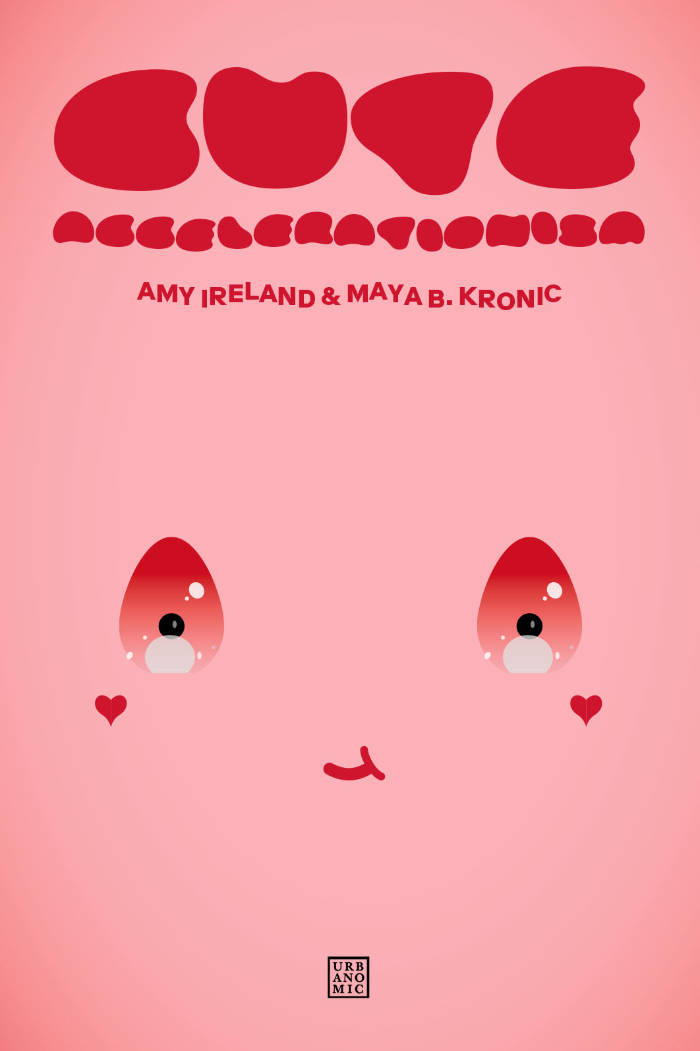
Cute Accelerationism
Involuntarily sucked into the forcefield of Cute, Amy Ireland and Maya B. Kronic decided to let go, give in, let the demon ride them, and make an accelerationism out of it—only to realise that Cute opens a microcosmic gate onto the transcendental process of acceleration itself.
Joining the swarming e-girls, t-girls, NEETS, anons, and otaku who rescued accelerationism from the double pincers of media panic and academic buzzkill by introducing it to big eyes, fluffy ears, programming socks, and silly memes, they discover that the objects of cute culture are just spinoffs of an accelerative process booping us from the future, rendering us all submissive, breedable, helpless, and cute in our turn. Cute comes tomorrow, and only anastrophe can make sense of what it will have been doing to us.
Evading all discipline, sliding across all possible surfaces, Cute Accelerationism embraces every detail of the symptomatology, aetiology, epidemiology, history, biology, etymology, topology, and even embryology of Cute, joyfully burrowing down into its natural, cultural, sensory, sexual, subjective, erotic, and semiotic dimensions in order to sound out the latent spaces of this Thing that has soft-soaped its way into human culture.
Traversing tangents on natural and unnatural selection, runaway supernormalisation, the collective self-transformation of genderswarming cuties, the hyperstitional cultures of shojo and otaku, denpa and 2D love, and the cute subworlds of aegyo and meng, moé and flatmaxxing, catboys and dogon eggs, bobbles and gummies, vore machines and partial objects, BwOs and UwUs…glomping, snuggling, smooshing and squeeeeing their way toward the event horizon of Cute, donning cat ears and popping bubbles as they go, in this untimely philosophical intensification of an omnipresent phenomenon, having surrendered to the squishiest demonic possession, like, ever, two bffs set out in search of the transcendental shape of cuteness only to realise that, even though it is all around us, we do not yet know what Cute can do.
Seriously superficial and bafflingly coherent, half erudite philosophical treatise, half dariacore mashup, 100 percent cutagion, this compact lil’ textual machine is a meltdown and a glow up, as well as a twizzled homage to Deleuze and Guattari’s A Thousand Plateaus. Welcome to the kawaiizome: nothing uncute makes it out of the near future, and the cute will very soon no longer be even remotely human.
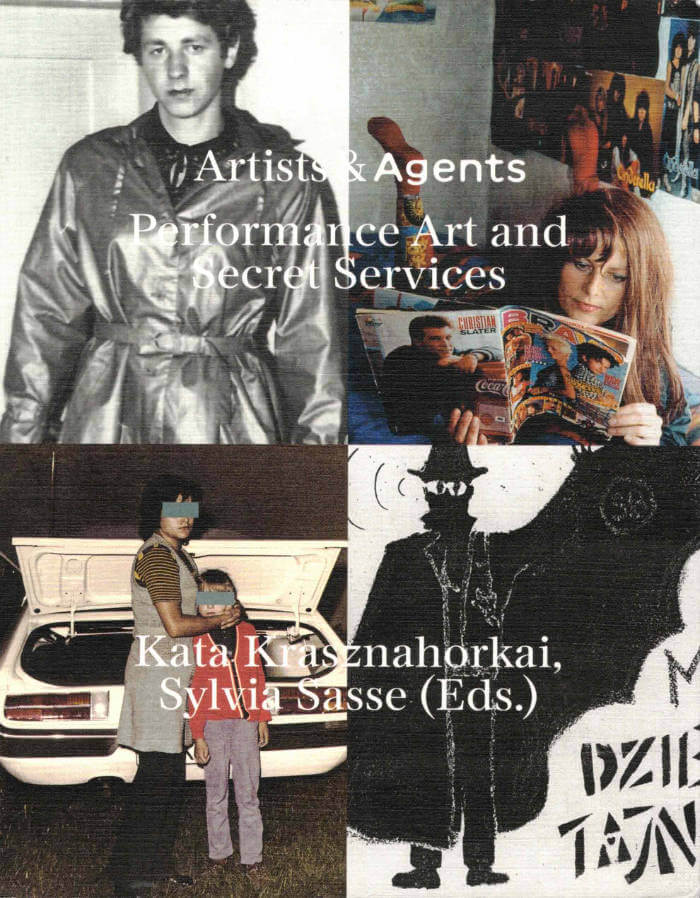
Artists & Agents. Performance Art and Secret Services
Sylvia Sasse, Kata Krasznahorkai
Subversion does not belong to anyone. It can come from artists who outwit the state or from intelligence agencies who infiltrate the art scene on behalf of the state. But what happens when the two sides meet? After the old state security archives in many Eastern European countries were opened, it became possible for this interaction to be studied in detail.
Drawing on scientific essays and artistic contributions, the book shows how the secret police monitored happenings, performance art, and action art and looks at the debates they had about the new art form; it also demonstrates not only how the police documented artistic actions in detail using forensic techniques but also how they manipulated them and sought to thwart them with counter-actions. In addition to this, the book also reveals how artists dealt with the possibility that they were being observed by the secret police and how they now work with the material stored in the archives maintained by the intelligence services.

Publi Fluor, Letter Business in Brussels
A self-taught typographic letterer, Chrystel Crickx used to cut out letters by hand and sell them by the piece in her Publi Fluor shop in Schaerbeek, Belgium. Commercialized between 1975 and 2000 for local advertising and signage purposes, these letters have since been digitized and made more widely available to users outside of the Belgian borders and in other contexts. At the margins of standard means of communication, they have contributed to shape (and still do) the urban visual landscape, in Brussels and elsewhere.
This non-standard, collective essay attempts both to recount the life of a type model — as well as of its successive authors and their tools — while expanding the field of investigation to examine the cracks between the different stories summoned up by Chrystel Crickx's practice summons up.
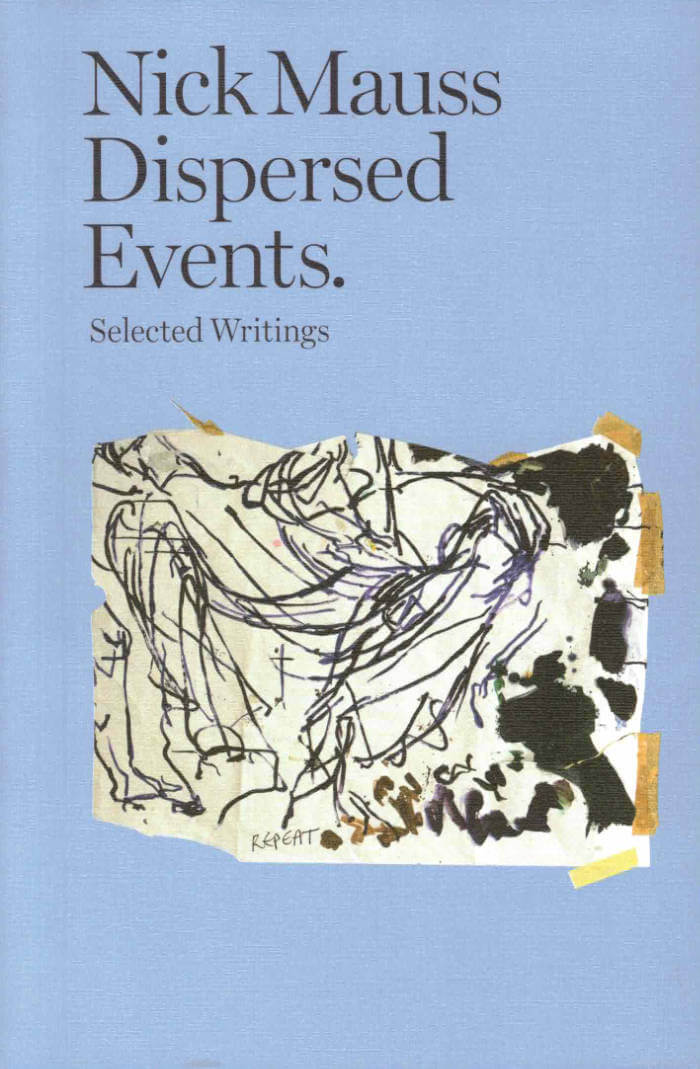
Dispersed Events. Selected Writings
Dispersed Events brings together for the first time Nick Mauss’ essays from the last fifteen years. Shimmering with the urgency of a new generation of queer thinkers, Mauss’ writing refracts contemporary art through histories of decorative art, film, theater, and dance.
An artist renowned for critically and poetically reconfiguring inherited genealogies and hierarchies of visual culture and art history, Mauss engages writing as a space for relentlessly activating counter-histories, repositioning the voice of the artist and the readers along the way. Whether he considers the practice of artist Lorraine O’Grady, the radical fashion of Susan Cianciolo, the anarcho-vaudevillian theater of Reza Abdoh, or the potential for textiles to disclose a different way of thinking, Mauss insists on the intense power of forms and feelings in their actual rather than enforced prehistories. Reevaluating experiments in fashion, dance, and the decorative arts on the same plane as painting, sculpture and cinema, he locates art as taking shape in the middle of conversations—“between art history and any afternoon.”
“Among what might initially appear, following Mauss, ‘a wildly inscrutable web of lineages,’ the reader quickly perceives unexpected, unheralded, conjunctions: affiliations, alignments, and affinities. . . . It generates a conviction that, in the best sense, is partisan. Singular, independent, illuminating.” — from the foreword by Lynne Cooke
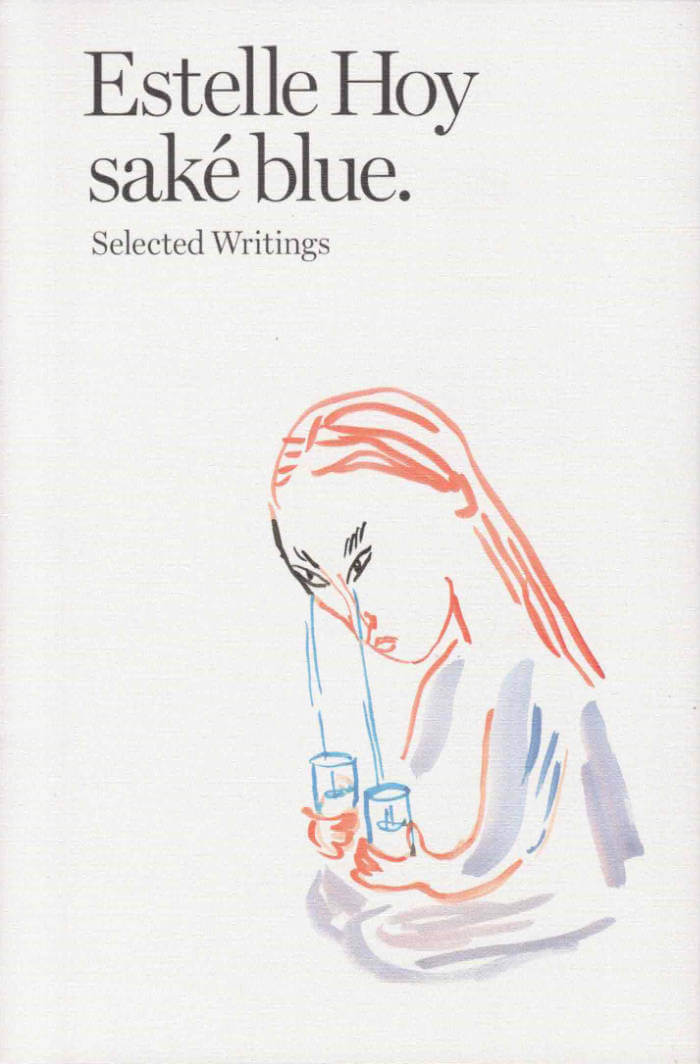
saké blue. Selected Writings
Can critical thinking spring from both a fortune cookie and Jacques Lacan’s most obscure seminar footnote? Estelle Hoy says yes. In saké blue, overpriced cheesecakes are the starting point for an essay on art writing; shoplifting in Berlin opens to a reflection on the economies of activist practices; fiction allows us to discuss the legacy of institutional critique, queer mélanges, or quiet melancholy. To her, the story of art becomes more nuanced in light of lyrics by Arthur Russell, the posthumous sorrow of Sylvia Plath, or a poem by Yvonne Rainer.
saké blue gathers critical essays, art reviews, and poetic fiction. Written in dialogue with the work of Martine Syms, Marlene Dumas, Hervé Guibert, or Camille Henrot, these texts combine the subjective and analytic, addressing power relations and the force of affect. Hoy spares nothing—and no one, exposing cultural clichés and urgent political issues through fast-paced acerbity. She advocates the work of women artists, mocks stereotypes, questions myths, and champions desire, sadness, and boredom. Simultaneously beautiful, lyrical, and cutthroat, her writing echoes to the reader like l’esprit d’escalier—we think of the perfect reply just a little too late.
“Estelle Hoy practises philosophy as an unsettled but deeply committed query into existing together. She reads, she looks, she writes, to find out something essential about the future and living for it.”
—Lisa Robertson, author of The Baudelaire Fractal
“Estelle Hoy's prose slap and bite, saké blue is a sharp pleasure to read.”
—Calla Henkel, author of Scrap
“Hoy’s renditions of all-too familiar scenes are made more visceral than life with sparkling prose and a sly attention to life’s many shifting values that feels more than appropriate for anyone truly interested in art.”
—Natasha Stagg, author of Artless
Edited by Antonia Carrara
With an introduction by Lisa Robertson

Énergies
Les sculptures et les films de Judith Hopf sont alimentés par des réflexions sur les relations que les êtres humains entretiennent avec la production et la technologie. Pour Énergies, sa première exposition monographique en France qui eut lieu conjointement à Paris à Bétonsalon et au Plateau, Frac Ile-de-France, l’artiste s’est concentrée sur cet élément invisible dont la quête accompagne notre quotidien et nos activités, produit par la conversion de ressources naturelles en puissance. Ce catalogue réunit des reproductions de dessins inédits, un entretien avec l’artiste et un texte critique de Tom Holert qui fait retour sur vingt années de travail.
Judith Hopf's sculptures and films are fuelled by reflections on the relationship human beings have with production and technology. For Énergies, her first solo exhibition in France, held jointly in Paris, at Bétonsalon and Plateau, Frac Ile-de-France, the artist focused on this invisible element whose quest accompanies our daily lives and activities, produced by converting natural resources into power. This catalog features reproductions of previously unpublished drawings, an interview with the artist and a critical text by Tom Holert, looking back over twenty years of work.
Textes / Texts
- François Aubart, Xavier Franceschi et Émilie Renard, "À propos d’énergie, d’amour et de chansons : conversation avec Judith Hopf"
- Tom Holert, "Changements de rythme : La méthodologie énergétique de Judith Hopf"
- François Aubart, Xavier Franceschi et Émilie Renard, "On Energy, Love, and Songs: Conversation with Judith Hopf"
- Tom Holert, "Changing Pace: Judith Hopf’s Energetic Methodology"
Traduction / Translation
Jean-François Caro
Louise Ledour
Typesetting : Olivier Lebrun
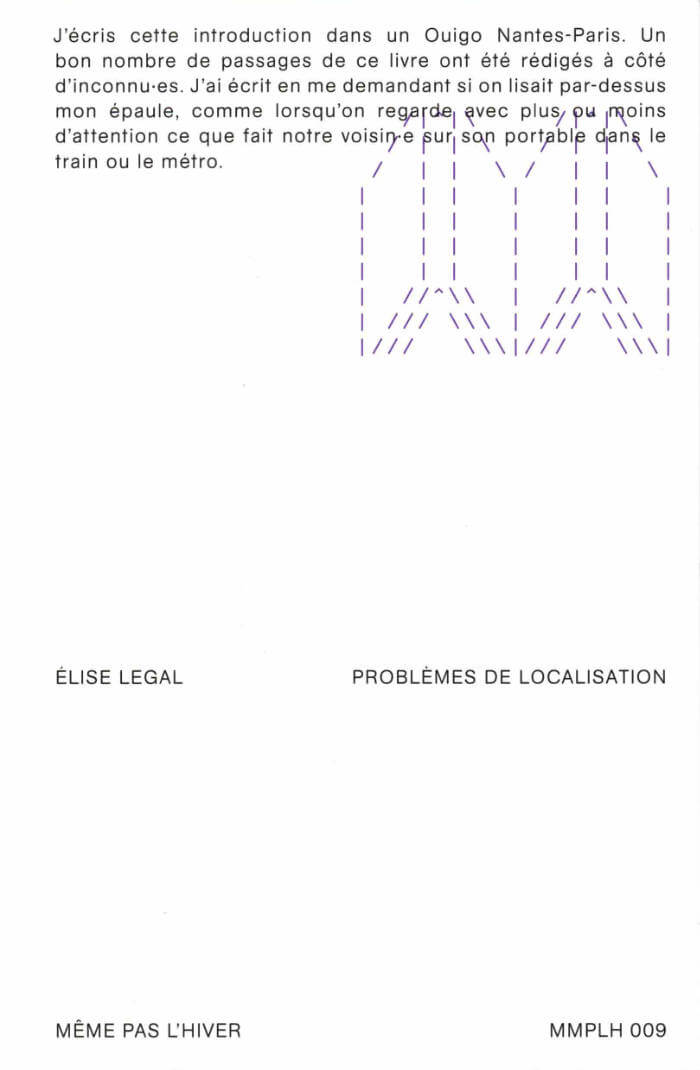
Problèmes de localisation
En sortant de l’école d’art, Élise Legal parcourt un monde de crises économiques, d’absurdités politiques et d’angoisses écologiques. Un monde dans lequel elle doit désormais légitimer sa démarche artistique dans des dossiers qui en font une fiction.
Problèmes de localisation contient sept textes, composés d’analyses critiques, de récits personnels et de poèmes, qui racontent cette entrée dans un environnement où circulent les corps, les marchandises, les informations et les capitaux. Élise Legal s’y déplace en voiture, en co-voiturage, en train, en bus ou en avion, découvrant ce que ce monde de transaction et de fluidité fait au langage. Elle cherche à comprendre comment il est incarné, échangé et habité dans les voix des pilotes d’avion, des startupers ou du président de la République, dans les textes de loi, les formulaires de demandes de bourses, la parole de ses enseigant·es, dans les textes de théorie critique comme dans la poésie des banquiers.
Élise Legal est artiste et autrice. Elle a étudié à l’École nationale supérieure des beaux-arts de Lyon et au Sheffield Institute of Arts. À travers une approche pluridisciplinaire qui mêle images trouvées, dessin et poésie, elle porte une attention particulière à la manière dont le langage et les corps coexistent. Elle poursuit également une thèse de recherche-création à Paris 8 qui porte sur l’agir politique de la poésie.
Graphisme : Olivier Lebrun

A User's Manual to Claire Fontaine
In the first monograph on the feminist conceptual artist collective Claire Fontaine, political theorist and somatic practitioner Anita Chari explores the artist's theoretical and political innovations to illuminate a more haptic, embodied approach to the practice of critical theory.
A User's Manual to Claire Fontaine explores the work of the feminist conceptual artist collective Claire Fontaine through the lens of her theoretical and political innovations, both inside and outside the context of contemporary art. Theorizing the ways in which Claire Fontaine's experimental approach can illuminate a more haptic, embodied practice of critical theory, this book delineates a series of theoretical techniques and procedures at the core of the artist's work, among them defunctionalization, Institutional Critique, human strike, tactile mimesis, desubjectivation, détournement, magic materialism, and feminist materialism.
Political theorist and somatic practitioner Anita Chari illuminates a larger field of practice for those working within the world of critical theory with this "user's manual" that seeks to reinvest theory with use value, drawing on the resources of critical contemporary art to engage with critical theory in ways that can become embodied, sensate, and tactile, and thus inform contemporary political practices.
"Fluently traversing critical theory, political philosophy, and artistic discourse, this is a brilliant, engaging book on the art and writings of Claire Fontaine—'readymade artist' and conceptual provocateur—as well as a vital elucidation of paths toward a transformative mode of living in the present. Writing with and through rather than, as usual, 'on' her subject, Chari provides her readers with a 'how-to' manual to Claire Fontaine's practice, finding in it a model for embodied resistance."—Tom McDonough, author of The Beautiful Language of My Century
Anita Chari is a political theorist and writer based in Portland, Oregon and is Associate Professor of Political Science at the University of Oregon. Her work explores the significance of aesthetics, artistic practices, and embodiment for critical theory and practice.
Claire Fontaine is a feminist, conceptual artist, founded in Paris in 2004.
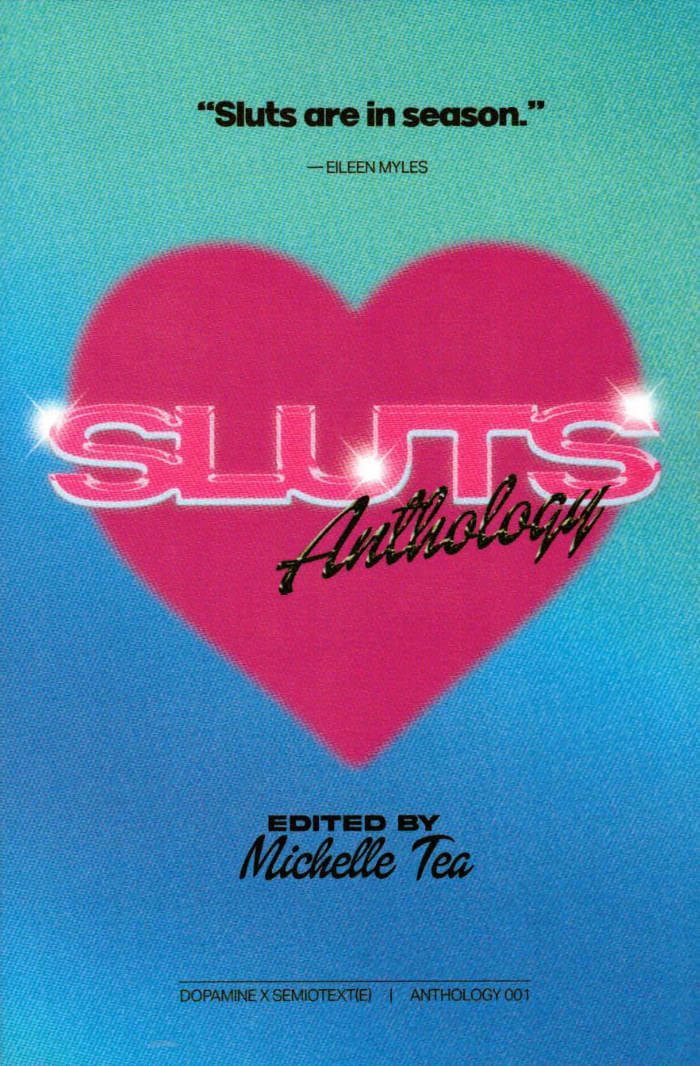
Sluts: Anthology
What it means to be sexually promiscuous in contemporary American culture, edited by cult-favorite author Michelle Tea.
SLUTS, the first publication from vulgarian queer publisher DOPAMINE BOOKS, is an exploration of what it means to be sexually promiscuous in contemporary American culture. Featuring personal essays, spilled secrets, fiction, memoir, and experimental works, SLUTS asks writers and readers to investigate the many ways the notion of the slut impacts our inner and outer lives, as a threat or an identity, a punishment or an aspiration, a lifestyle, an aesthetic, a philosophy and rallying cry. From hideous and terrifying first encounters to postapocalyptic polyamory, from unionizing sex workers to backstage tableaux of sex and drugs and rock and roll, SLUTS's stories probe the liberating highs and abject lows of physical abandon. Featuring work from performer Miguel Gutierrez, hailed by the New York Times as “an artist of ordered excess”; former Nylon magazine editor in chief Gabrielle Korn; award-winning author Brontez Purnell; Whore of New York author Liara Roux; National Book Critics Circle Award winner Jeremy Atherton Lin; and a host of additional artists and writers, SLUTS reveals the knowledges provoked by a dalliance with desire.
Contributors
DL Alvarez, Vera Blossom, Chloe Caldwell, Cristy Road Carrera, Sam Cohen, Tom Cole, Lydia Conklin, jimmy cooper, Lyn Corelle, Jenny Fran Davis, Cyrus Dunham, Hedi El Kholti, Robert Glück, Miguel Gutierrez, Gary Indiana, Taleen Kali, Cheryl Klein, Gabrielle Korn, Jeremy Atherton Lin, Nate Lippens, Meredith Maran, Carta Monir, Amanda Montell, Carely Moore, Bradford Nordeen, Baruch Porras-Hernandez, Kamala Puligandla, Brontez Purnell, Liara Roux, Andrea Sands, Daviel Shy, Jen Silverman, Anna Joy Springer, Laurie Stone, McKenzie Wark, Zoe Whittall.

Kish, An Island Indecisive by Design
Babak Afrassiabi, Nasrin Tabatabai
In Kish, An Island Indecisive by Design, artists Nasrin Tabatabai and Babak Afrassiabi explore the modern development of an Iranian island in the Persian Gulf. Removed from mainland Iran, Kish is a place where extremes in politics, ideology and urban design intersect. The island's many years of infrastructural indecision is distinctly evident in its architecture, which lacks any trace of coherence or feel for locale. This volume gives an often moving account of the chaos of middle-eastern modernity.

The Alphabet Book
In 1971, Michael Morris and Vincent Tarsov—founders of the Vancouver-based artist network Image Bank—invited Eric Metcalfe, Gary Lee Nova, Glenn Lewis and Paul Oberst to create their own, unique alphabet. NowForty years later, with the permission of the participating artists and the help of Image Bank, these historic silk-screened alphabets have finally been published together. The Alphabet Book is designed by Marc Hollenstein, who was inspired to reinitiate the alphabet publication project after having a conversation with Glenn Lewis during the opening of Lewis’ retrospective exhibition at Kunstverein back in 2014.

GAAG, the Guerrilla Art Action Group, 1969–1976
Jean Toche, Jon Hendricks and 1 more
This is the reissue of the long out-of-print publication GAAG: The Guerrilla Art Action Group, 1969–1976: A Selection, first published in 1978.
The book serves as the primary text to the significant work of the activist artist group GAAG (Jon Hendricks, Poppy Johnson, Silvianna, Joanne Stamerra, Virginia Toche and Jean Toche), both as a document of the group’s ideological and logistical concerns, and more broadly as a historical record for fifty-two of the many political art actions they carried out through the late 60s and early 70s.
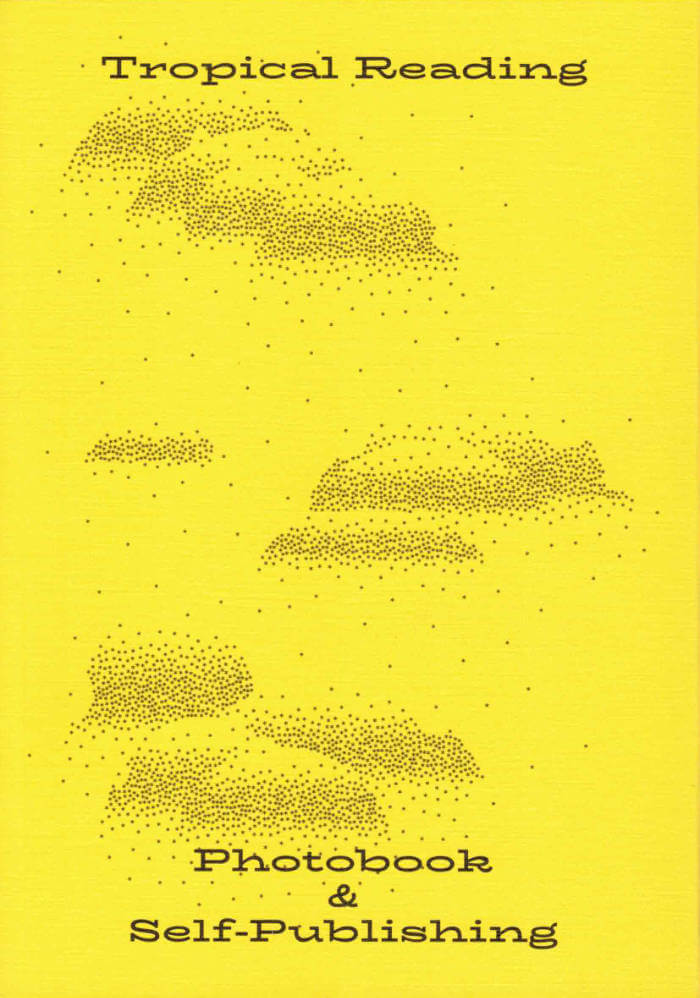
Tropical Reading - Photobook and Self-Publishing
Tropical Reading: Photobook and Self-Publishing illustrates the photography practitioners and artist collectives from each city in Southeast Asia, examining why they chose to get into self-publishing. It explores how independent art bookstores came to be the social parlours of the self-publishing crowd. Furthermore, observes how the outsider artists, archives and arts initiatives of Southeast Asia came to shape the face of photography and self-publishing in their respective cities.
The index is a compilation of our project field research, condensing the profiles of all the interviewees – from people to bookstores to organisations – to make a kind of alternative Yellow Pages for the Southeast Asian art scene.
Comes with pink, green and yellow covers. Colour covers supplied randomly.

Ad Học
Teline Trần's Ad Học traverses the improvisational structures that shape social life in order to reflect their valences as both insufficient and abundant. In their first poetry chapbook, Trần locates those junctures with bittersweet pleasure and biting critique and asks how to sustain both at once. This is, Trần shows us, the work of living, against and within the ongoing attrition and amnesia at scales historical and governmental, interpersonal, familial, and social. Ad Học asks the reader to turn inwards, towards a personal politic, to self-revolution, in order to seek horizons dreamier, queerer, and hopefully insurgent.
Teline Trần is a writer from Orange, California or Gabrieleño/Tongva land. They write about home and interstitial faith via several mediums such as fiction, poetry, film, and ultimately, the browser. Teline works as the Membership and Community Engagement Coordinator at Wendy’s Subway, where they were a Fellow in 2020. They also work as the Development Coordinator at Mekong NYC, a Southeast Asian grassroots organization in the Bronx. They hold a degree in Comparative Literature from Reed College.
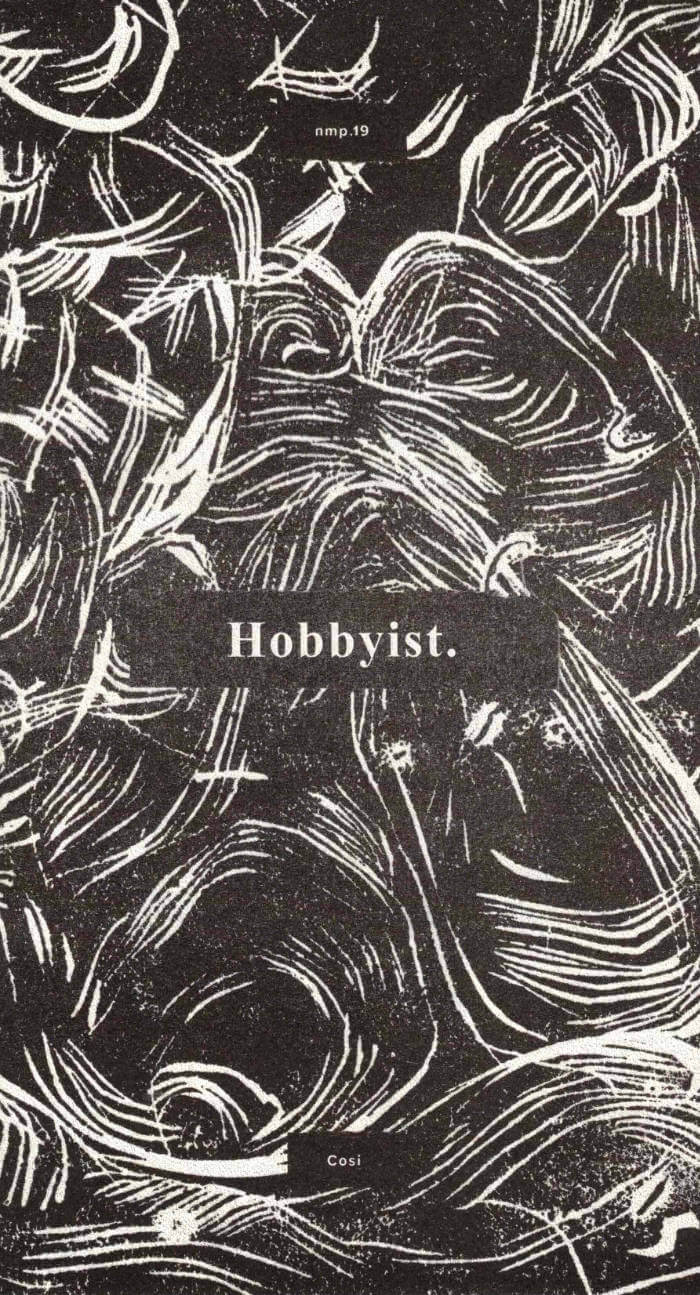
nmp.19 Hobbyist
artwork
black throughout, blue dust jacket
risograph, paperback
saddle stiched
clorine & acid free glassine sleeve
28 pages + dust jacket
152 x 280 mm
first edition, edition of 100
signed
"…this collection of some twenty-eight artworks, being automatic, incongruent — graphite, charcoal, ink — rigid, finite and complete — convey an underestimated and complex sense of play, by which the author — simply Cosi (as if distilling the self in a single word could be conceived as simple) — becomes a diagrammatic example of a brilliant and full-cream adult, so disinterested in the conformity of adulthood that more difficulty is placed within the absurd notion itself" (note from the publisher)
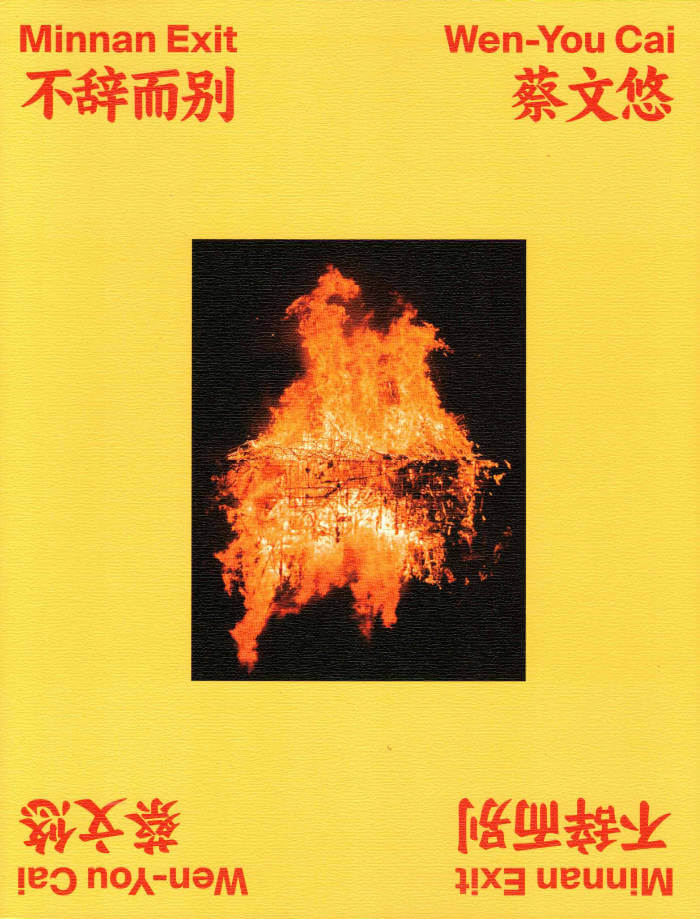
Minnan Exit
Since 2015, Wen-You Cai has returned on multiple occasions to her parents' hometown of Quanzhou, Fujian, to attend the funerals of her deceased relatives. The ceremonies in the Minnan region unfold like grand dramas in which she is both an observer and a participant. Throughout the ceremony, Wen-You is enveloped in the unknown; everything seems meticulously arranged. Amidst the overwhelming grief of losing loved ones, there exists a feeling of confusion, and taking photographs was one of the ways for her to engage in the funeral process.
For this photo series, Wen-You was initially confronted by her own fear of death, intertwined with her bewilderment and curiosity about the complex funeral rituals and its uniqueness inherent to Minnan culture. To demystify these subjects, Wen-You, joined by te editions, interviewed a funeral director who provides comprehensive “one-stop services,” a monk who hosts Buddhist ceremonies, and a folklorist of Minnan rituals. Minnan Exit can be interpreted as many things–a family album, a curated collection of photographs, an unfinished journey of discovery, as well as the process of Wen-You's reconciliation with her mortality.
Minnan Exit was designed by an independent graphic design studio, RELATED DEPARTMENT. Through the artist's lens, the design team sought inspiration from funeral objects and rituals, to create a visual concept for the publication's structure and layout with the regional characteristics of Minnan.
Special Interviewees: Chen Huaxian, Master Puyuan, You Gongchu (A-Bue)

N°1 The Lost Society
There cannot be more possibilities and layers of complexity embodied in food throughout human development. On one hand, it constructed a system that assembles taste, cultural memory and historical movements; on the other hand, the correlation between food and geography provides a hidden motivation to examine human behaviours and social transformation.
This inaugural issue of te magazine adopts Ye Wuji's "The Lost Society" as the central theme. The term "lost" means ephemeral silence and enfeeblement rather than disappearance and extinction. This means that many cultures only dissipated temporarily, and some are metamorphised. Food happens to witness this transition, and the word "society" refers to a collective destiny. In this issue, we invited 13 creative practitioners of different disciplines — to bring in and reflect upon their respective expertise, knowledge system and research trajectories from and in anthropology, sociology, and contemporary art — to explore food as a multi-faceted intricacy, at the same time reconstruct the relationship between food and geography.
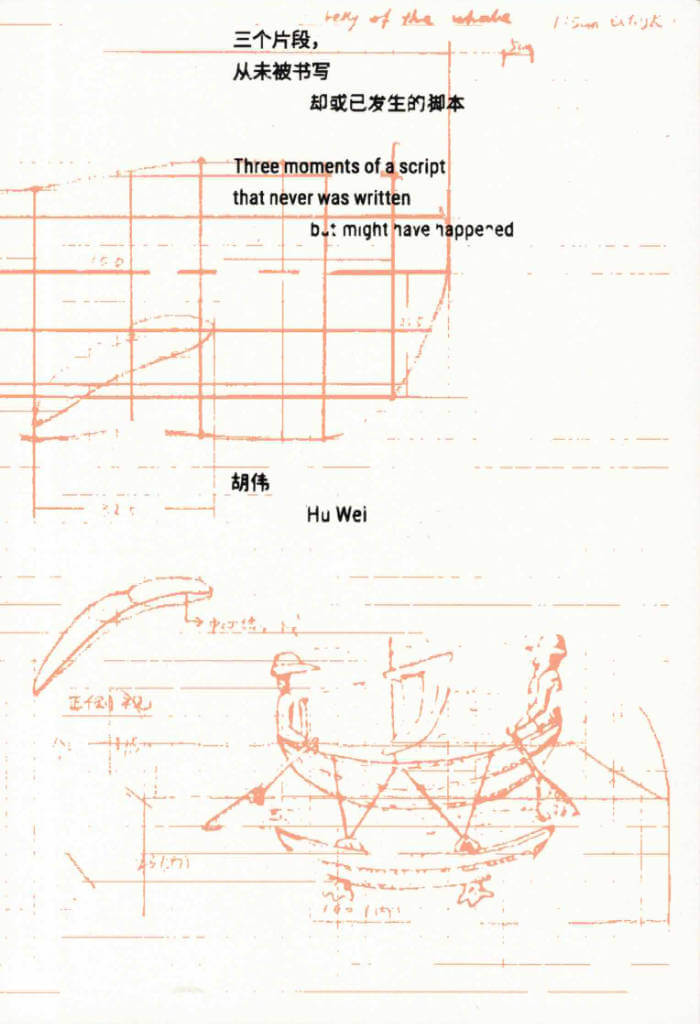
Three moments of a script that never was written but might have happened
This publication departs from three video works by the artist Hu Wei, exploring the possibilities of devising new scripts within the manifold connections between materials for creative works, images, and texts.
The first part of the publication transcribes and recompiles the narrations in his videos into three sets of juxtaposed scripts. Each of these textual fragments showcases an “anatomical section of an era” from disparate geopolitical contexts: a family letter from Sabah, a set of Rashomonian testimony, and an anecdote about the anonymous.
The second part is a notebook-like atlas that unfolds following the clues of three keywords: “Fabrication,” “Anonymity,” and “Boundary.” Within this section, different types of images and texts, including factual materials, embodied research and survey records, as well as fabricated documents, interlace with each other. They serve as an interrogation, extension, reconstruction, and reassemblage of three muted histories or events.

Mycoscores / Choreospores
Mycoscores / Choreospores is a set of artistic scores for exploring the connections between fungal and human ways of being, particularly through movement and dance. The scores propose starting points for dancing, weaving together social connections, composing and exploring performativity.
The publication consists of 31 cards, each presenting a single score, a booklet with a text entitled Fungi Feel, the introduction, instructions, a glossary and additional short text entries accompanying the scores.
Scores, writing and concept by Maija Hirvanen
Graphic design: Arja Karhumaa
Publisher: Friends of Physical Contemporary Art, in the frame of Performing Portals project. In collaboration with DAS Research/DAS Publishing, Academy of Theatre and Dance, Amsterdam. Published Jan. 2024

Ce qui fut et ce qui sera
This collective book devoted to the work of Sammy Baloji explores how the artist, born in the DRC in 1978, attempts to “restore defeated connections”.
How to think about the memory sifted through colonial violence? What effects does the mining of yesterday and today in Katanga and elsewhere have on the project of a common future? How does form make history beyond erasure?
Sammy Baloji (born 1978 in Lubumbashi, Democratic Republic of Congo)'s photographs and videos have their roots deep in the ongoing upheavals in Democratic Republic of Congo: the often invisible consequences of the mining of rare minerals used for electronic components; China's gigantic investments all over the African continent; and his country's industrial and cultural heritage. His photographs have taken out many prizes including the Prince Claus Award, the Spiegel Prize and the Rolex Award and have been shown at the Rencontres d'Arles, the MMK Museum für Moderne Kunst (Frankfurt), the Gulbenkian Foundation (Lisbon/Paris) and the Smithsonian National Museum of African Art (Washington).
Texts by Sammy Baloji, Lotte Arndt, Julien Bondaz, Baptiste Brun, Jean-François Chevrier, Dominique Malaquais, Fiston Mwanza Mujila.
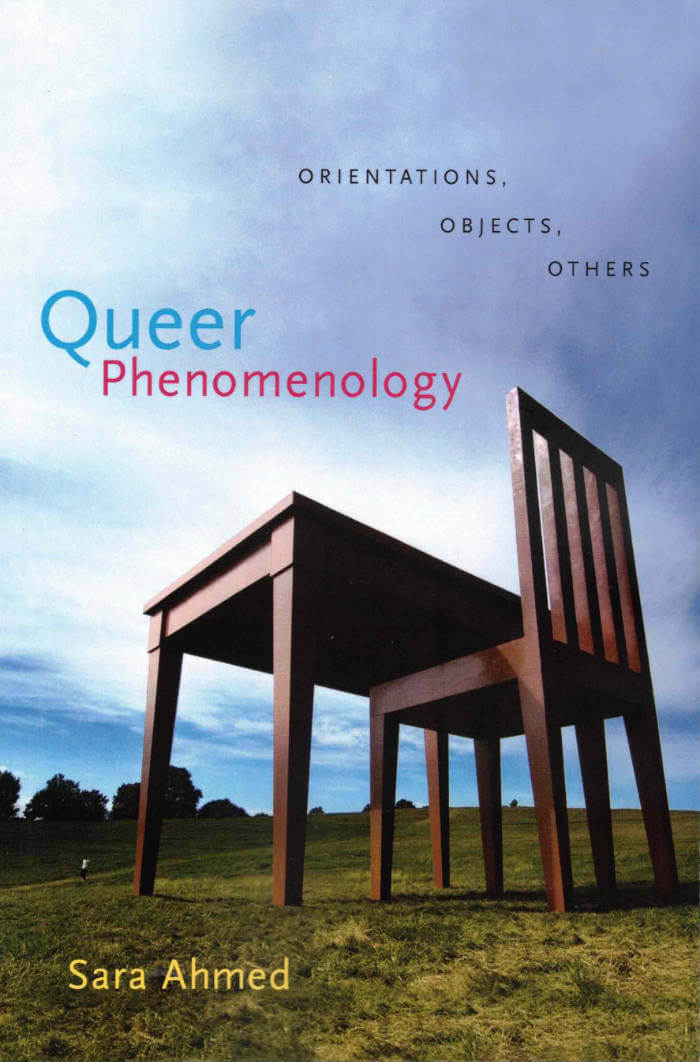
Queer Phenomenology
In this groundbreaking work, Sara Ahmed demonstrates how queer studies can put phenomenology to productive use. Focusing on the “orientation” aspect of “sexual orientation” and the “orient” in “orientalism,” Ahmed examines what it means for bodies to be situated in space and time. Bodies take shape as they move through the world directing themselves toward or away from objects and others. Being “orientated” means feeling at home, knowing where one stands, or having certain objects within reach. Orientations affect what is proximate to the body or what can be reached. A queer phenomenology, Ahmed contends, reveals how social relations are arranged spatially, how queerness disrupts and reorders these relations by not following the accepted paths, and how a politics of disorientation puts other objects within reach, those that might, at first glance, seem awry.
Ahmed proposes that a queer phenomenology might investigate not only how the concept of orientation is informed by phenomenology but also the orientation of phenomenology itself. Thus she reflects on the significance of the objects that appear—and those that do not—as signs of orientation in classic phenomenological texts such as Husserl’s Ideas. In developing a queer model of orientations, she combines readings of phenomenological texts—by Husserl, Heidegger, Merleau-Ponty, and Fanon—with insights drawn from queer studies, feminist theory, critical race theory, Marxism, and psychoanalysis. Queer Phenomenology points queer theory in bold new directions.